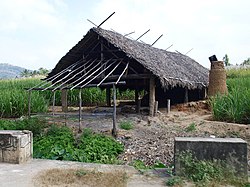Marayoor
|
Marayur മറയൂർ |
|
|---|---|
| Town | |

Shed for making jaggery
|
|
| Coordinates: 10°16′29″N 77°09′36″E / 10.274735°N 77.160032°ECoordinates: 10°16′29″N 77°09′36″E / 10.274735°N 77.160032°E | |
| Country |
|
| State | Kerala |
| District | Idukki |
| Area | |
| • Total | 224.99 km2 (86.87 sq mi) |
| Population (2001) | |
| • Total | 20,575 |
| • Density | 91/km2 (240/sq mi) |
| Languages | |
| • Official | Malayalam |
| Time zone | IST (UTC+5:30) |
| PIN | 685620 |
| Telephone code | 04865 |
| Vehicle registration | KL-68 |
Marayur or Marayoor is a town in Idukki district of Kerala, India. It is located 42 kilometers north of Munnar on SH 17 connecting Munnar with Udumalpet, Tamil Nadu. Marayur is the only place in Kerala that has natural sandalwood forests. Ancient dolmens and rock paintings in Marayur date back to the Stone Age. In 1991 Marayur had a population of 9,590.
Marayur claims to be a part of a Stone Age civilization that is as old as 10,000 B.C. It is also home to a later period of large-scale dolmen-building. People migrated from Tamil Nadu to this area when the Madurai king Thirumalainaicker was defeated by Tippu Sultan, in the eighteenth century CE. The migrants created five villages, being Kanthalloor, Keezhanthur, Karayur, Marayur and Kottakudi. These villages were called the "Anju nadu", literally meaning “five lands”.
Also called Muniyaras, these dolmens belong to the Iron Age. These dolmenoids were burial chambers made of four stones placed on edge and covered by a fifth stone called the cap stone. Some of these Dolmenoids contain several burial chambers, while others have a quadrangle scooped out in laterite and lined on the sides with granite slabs. These are also covered with cap stones. Dozens of Dolmens around the area of old Siva temple (Thenkasinathan Temple) at Kovilkadavu on the banks of the River Pambar, and rock paintings on the south-western slope of the plateau overlooking the river have attracted visitors. Apart from the dolmens of Stone Age, several dolmens of Iron Age exist in this region especially on the left side of river Pambar as is evident from the usage of neatly dressed granite slabs for the dolmens. At least one of them has a perfectly circular hole of 28 cm diameter inside the underground chamber. This region has several types of dolmens. Large number of them are overground with about 70–90 cm height. Another type has a height 140–170 cm. There is an overground dolmen with double length up to 350 cm. Fragments of burial urns are also available in the region near the dolmens. This indicates that the dolmens with 70–90 cm height were used for burial of the remains of people of high social status. Burial urns were used for the burial of the remains of commoners. The dolmens with raised roofs might have been used for habitation of people. Why some people lived in the cemeteries has not been satisfactorily explained.
...
Wikipedia
